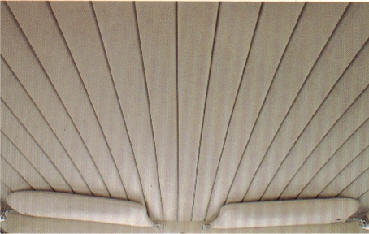 |
330 GT Registry |
 |

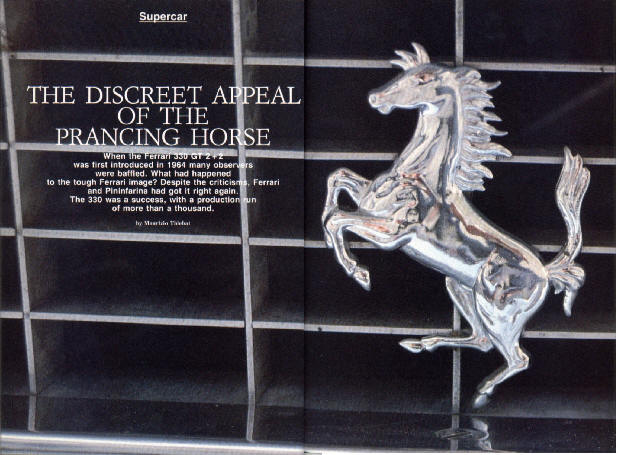
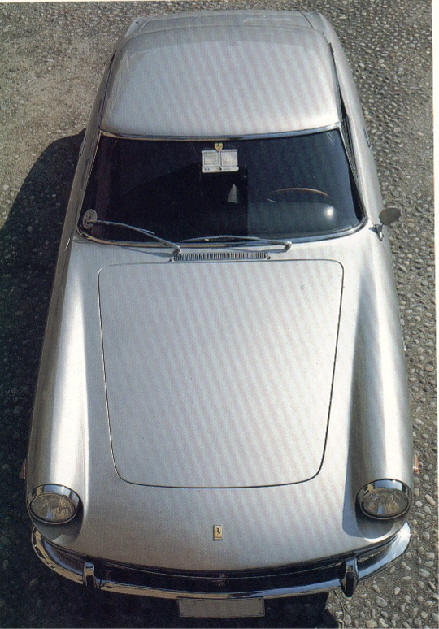
Le Mans, 1962. In oppressive heat, some 250,000 spectators at the 30th 24-hour race witnessed the success of Ferrari’s 330 TR/LM driven by Gendebien and Hill — the Maranello constructor’s sixth victory in the prestigious French event. Gendebien took the lead on the second lap and from that moment the number six Ferrari was in control.
During his spell at the wheel, Phil Hill set a new lap record, covering the circuit’s eight miles in 3 min 57.3 seconds at an average speed of 127.6 mph. Over the full 24 hours, Gendebien and Hill drove 2781 miles averaging 115.9 mph and beating the second car, Noblet and Guichet’s privately-entered Ferrari 250GT0, by almost 50 miles.
The winning Ferrari was the latest development of the glorious Testa Rossa, powered by the the 4-litre type 209 engine of which Enzo Ferrari had high hopes. His French victory was most satisfying: here was the engine the Commendatore had been looking for.
Ferrari
had many things on his mind. In America, thanks to the hard work and dynamism of
Luigi Chinetti, his cars were selling well, but there was ominous debate about
emissions controls. For the time being it was only talk:
although concrete measures weren’t introduced until 1968, it was wise to be
looking to the future. Enzo Ferrari had a profound knowledge of engines. He was
well aware that emissions control systems were bound to dampen down the
performance of his high-tech jewels, and he could not allow his cars to lose
their edge in so important a market as the United States. The only solution was
to build bigger, more powerful engines.
Glancing over his shoulder, he also realised that direct rivals, such as Aston
Martin and Maserati, were intent on seducing the demanding coterie of high-
performance car buyers by producing powerful double-overhead-camshaft models.
First appearance
Maranello, 11 January 1964: Ferrari’s annual press conference. It was a sure bet that the majority of the 200 or so journalists present had come to see the new Formula 1 car, which featured a 1.5-litre, 12-cylinder boxer engine and Lucas electronic injection.
But
Enzo Ferrari had other priorities, and for him the key moment of the conference
was the presentation of his new road model, the 330GT 2+2, powered by the
4-litre type 209 engine — an addition to the Gran Turismo range of 250GT 2+2,
250GT Berlinetta and 250 Le Mans (the 250 GT 2 + 2 was taken out of production a
few months later). Ferrari also revealed that another powerful road model was
under development. This was the 500 Superfast, unveiled later that year at the
Geneva Motor Show: only a few of these cars were ever produced.
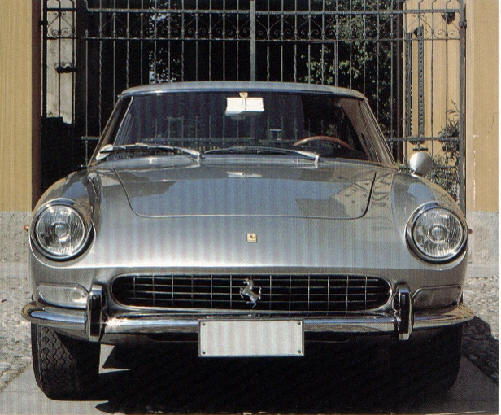 |
Introduced in 1964 with an uninspiring four-headlight arrangement, the Ferrari 330 GT2+2 underwent a revision in 1965: the controversial headlights were reduced to two and the whole front end was restyled on more traditional Maranello lines. The car shown in this article dates from 1967. |
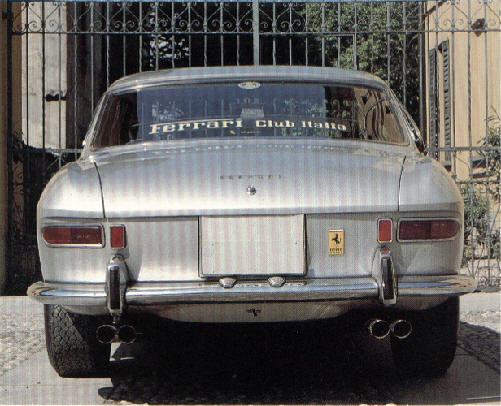 |
The curves of the 330’s tail also
disappointed many Ferrari admirers when the car was first introduced. In time, though, Pinin farina’s intuition again proved correct. The 330 GT 2+2 soon won over the public, and in due course 1085 of the cars were produced. |
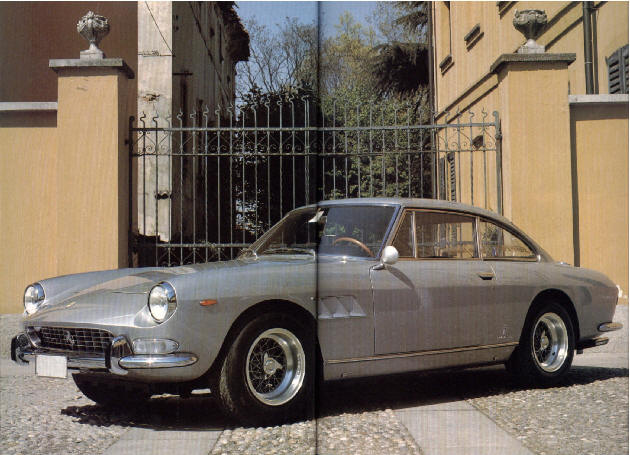
The 330 GT shown at the press conference was a white prototype, yet the new car was in fact already in production. Why wait? All the preparatory work in adapting the 4-litre engine for road use had already been carried out, starting in the winter of 1959, when a special version of the 400 Superamerica, first shown in public at that year’s Turin Motor Show, was built for Giovanni Agnelli (chassis number 1517 SA).
The
4-litre engine was subsequently fitted to the 250GT 2+2, resulting in the 330
America. Identical to the 2 + 2 coupé, this car had a very brief lifespan. Only
50 or so examples were built, some of them distinguished by the America insignia
on the rear bodywork.
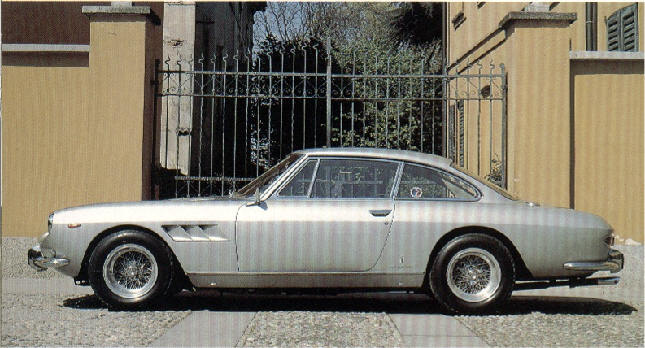
| Close-up of one of the wheel nuts. Borrani wire wheels were available as an optional extra on the ‘series two’ 330. Top. A Side view, showing the uncluttered, sober lines of the Maranello 2+2. | 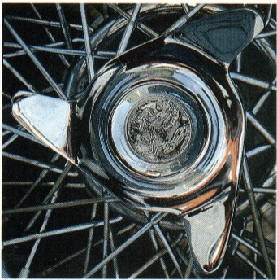 |
Although it resulted from a long process of evolution rather than a spontaneous act of creation, the 330 GT 2+2 was nevertheless a quite new Ferrari.
This was true even of the power unit. The 330 GT’s 4-litre type 209 engine really had little in common with that of the 400 Superamerica (type 163). When Ferrari embarked on its 4-litre project at the end of the 1950s, there were two possible options: to work from Aurelio Lampredi’s long-block engine or further develop the lighter, more compact unit designed in 1946 by Gioachino Colombo. In the event, it was Colombo’s engine that won out, partly because so many hours of research had gone into it, and the 60 degree Vi 2 held no secrets for the design department.
Work began in 1959. The stroke was increased to 71mm and the bore to 77mm (the maximum to be had from Colombo’s engine), giving a total cylinder capacity of 3967.4cc. The resulting type 163 was good on the whole, but had some drawbacks. Although this first-generation 4-litre proved adequate for road use, it tended to overheat under the more testing conditions of racing.
Further work was necessary. The engineers came up with a longer block, allowing for 94 mm between cylinder centres rather than the 90mm of the earlier model. This enabled the coolant to circulate better, eliminating the overheating problems.
There were no other changes, and it would take a real expert to distinguish the new unit (officially known as the type 209) from the type 163. Externally, it was fitted with a new belt-driven water pump, and 40 Ah alternator in place of the old dynamo.
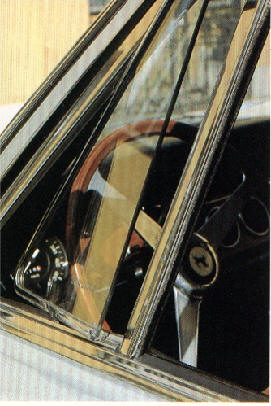 |
Left. Close-up of the front quarterlight. Right. One of the rear windows, which opened outwards. The cabin ventilation was inadequate to dispel the heat from the engine compartment. To remedy the defect, the post-1965 model could be supplied with air conditioning. |
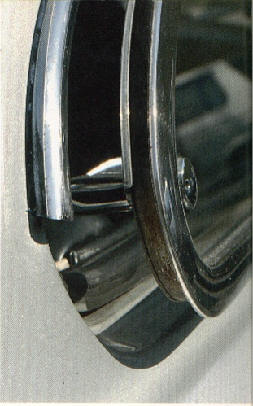 |
Ferrari’s stated power output for the 330 GT was 300bhp at 6000rpm. The compression ratio was 8.8:1, and fuel was supplied by three Weber 40 DF1 twin-choke downdraught carburettors.
The transmission components, essentially the same as those of the 250, were more than adequately strengthened to cope with the in crease in power. The four-speed gearbox, with Laycock overdrive, was modified so that the overdrive disengaged automatically when changing down from fourth to a lower gear.
The chassis was traditional: electrically welded oval-section tubes, with four engine mountings. The wheelbase, though was 50mm longer than that of the 250 GT 2 + 2 and the latest version of the 400 Superamerica. The independent front suspension consisted of wish- bones, coil springs and an anti-roll bar, while the rear featured a live axle with semi-elliptic leaf springs, trailing arms and coil springs. The Koni shock-absorbers were adjustable. Dunlop disc brakes were fitted to all four wheels with the front and rear circuits being in dependent.
Stylistically, the 330 GT 2+2 was unconventional for a Ferrari, departing from the aggressive, feline image typical of Pininfarina’s creations to take on a more sober and respectable appearance.
Even Sergio Scaglietti was amazed. After studying the drawings for the 330, he remarked: “We are terrified every time Pininfarina presents us with a new design. Time and again we feel that the public will never buy it. Far bolder, more innovative projects, once translated into reality, have proved already to be out of date. And yet, it is always the same story: Pininfarina has the extraordinary gift of understanding and interpreting public taste. Wait a few months and you will see: the same will happen with the 330”.
Scaglietti’s optimism was not echoed, however, by the more fervent Ferrari fans,
who were unconvinced by the four front headlights that were judged a feeble
concession to prevailing aesthetic fashions and by the rounded forms at the
tail.
|
The 330 and its rivals Once again, Enzo Ferrari’s judgement proved sound. Despite its rather tame appearance, which at first caused some consternation, the 330 GT 2+2 was an almost immediate success. Although it was produced for just three years (from 1964 to 1967), more than a thousand cars were produced at Maranello. In the months before it was withdrawn and replaced by the 365 GT2+2 the 330 was still selling well, in spite of fierce competition from other constructors. Ferrari’s neighbour and eternal rival, Lamborghini, had shown the 400 GT at the 1966 Geneva Motor Show. Credited with 370bhp and a top speed of 163mph, the CT from Sant A’gata had 2+2 bodywork by Touring and a price tag of 6,350,000 lire less than the 330. The other main Italian rival was the Maserati 3700 GTI Sebring, listed at 5,850,000 lire, an elegant two-seater designed by Vignale. The engine capacity was 3694cc, the output 245bhp. Its top speed was 156mph. Of the foreign marques, Jaguar was in the market with its E-type. powered by a 4235cc, six-cylinder in-line engine developing 269bhp and giving a top speed of 150mph. Price; 5,600,000 lire. Almost twice as expensive was the Aston Martin DB6 (six cylinders in line, 3995cc, 286bhp, 153mph). Introduced in October1965, it was on sale in Italy for an incredible 10,500,000 lire. |
Public debut
The 330 was unveiled to the general public at the Geneva Motor Show, from 12 to 22 March 1964. Pininfarina issued a press release describing the new Maranello GT in some detail. “(...) We have devoted a great deal of attention to the car’s aerodynamics, in general and in detail, taking account of wind tunnel tests carried out at Turin Polytechnic. The front, while retaining the classic Ferrari grille, has a new stream lined shape. The surface of the bonnet slopes down in typical Ferrari-Pininfarina style.
“The front lighting units”, the release continues, “consist of two pairs of headlights of different diameters. The larger pair can be dipped, while all four together provide the main beam. The lights are set into the ends of the wings in single chrome frames, constituting an original stylistic feature. This arrangement ensures outstanding visibility at night, as required by the vehicle’s high performance.
“The
light, streamlined side panels feature an air intake which sets off the
waistline and emphasises its elegant forms. The door handles are set into the
bodywork to avoid any dangerous projections. The low, streamlined roof, almost
totally surrounded by glass, flows harmoniously into the rear of the vehicle.
The rear light units are located at the end of the tail, completely set into the
body work and well protected by wrap around bumpers (...).“
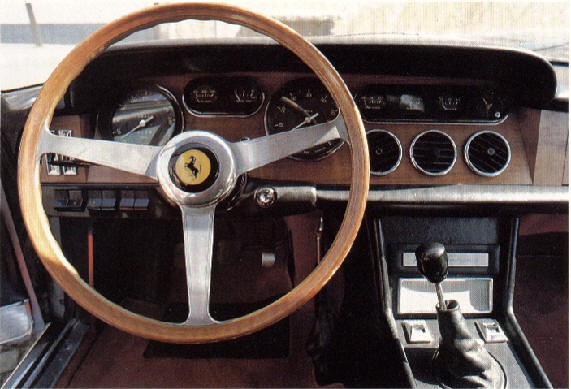
The press release goes on to describe the interior.
“The upper and lower parts of the leather-covered facia are padded with foam rubber, and the equipment, glove compartment and controls are ergonomically laid. out. The newly-designed instruments are arranged in the driver’s line of vision to avoid troublesome reflections.
“A special feature is the internal ventilation system, which channels and distributes adjustable flows of hot and cold air to all parts of the vehicle, from two air intakes located at the front of the car. Another air intake at the base of the wind screen admits fresh air to the cabin through two internal inlets, which can be adjusted for direction and air flow.
“The doors have flush interior openers and newly-designed padded armrests with integral hand- grips. The doors also feature a warning light, which comes on when they are open. The elegant roof lining is ribbed and padded to ensure first-class insulation against noise and heat, and takes up very little of the interior space. It is built without metal arch sup ports, thus eliminating a possible accident.
“As its name suggests, the car has two extremely comfortable and supportive front seats, with adjustable backs, and two further seats at the rear, with a central armrest and ashtray.”
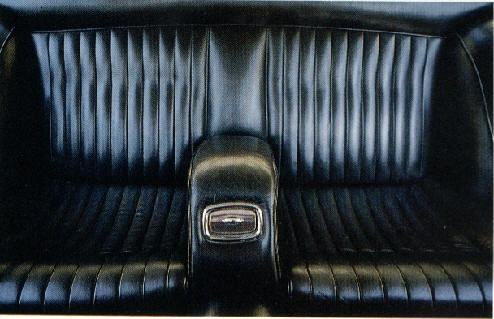 |
Ever long-legged passengers could travel in comfort in the rear seats, which were separated by an armrest incorporating an ashtray. |
|
Right. After 1965, the 330 was fitted with
suspended pedals. |
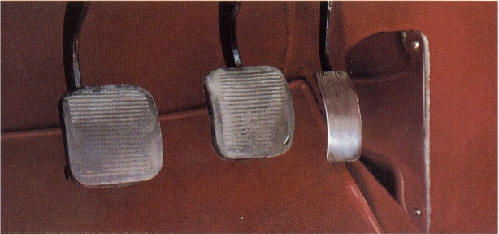 |
The
motoring press was virtually unanimous in its response to the new GT Ferrari:
there was no criticism of the engine, but the body work wasn’t what was expected
of a Ferrari. A typical reaction was that of Gregor Grant, writing in the source
of danger in the event of an English weekly Autosport, after test driving the
330 lent him by Ronnie Hoare, the famous UK importer and distributor of
Maranello cars. According to Grant, while every inch of the bodywork eloquently
testified to the genius of Battista Pininfarina, a little more originality could
have been expected in the nose treatment and the rather unsophisticated tail.
|
Neglected by the scale model makers Although it was a boom time for scale models, with various Italian and foreign marques introducing new cars, the elegant Pininfarina 330 GT2+2 was practically cold-shouldered by the manufacturers The French A.M.R. company was alone in marketing a special 1/43 reproduction of the single-headlight version. The white-painted bodywork is impeccably finished, as are the lights, including the lateral repeaters.
The wing mirror on the driver’s side is a faithful reproduction of the Vitaloni component which Ferrari fitted as an optional extra. The interior features are very fine, including the wooden steering wheel, rear-view mirror and ball- topped gearlever. The instrumentation is reproduced using transfers. Today, this outstanding model of the 330 GT 2+2 is a valuable item — a worthy addition to any collection of Ferrari GT cars. |
|
|
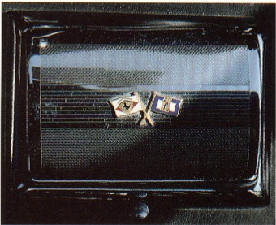
Above. A view of the roof lining. It was made of a ribbed, padded
material - without metal arch supports. |
Plenty of leg room
“However,” adds Grant, writing in the 28 August 1964 number of Autosport — “this sort of saloon (though saloon is not really the right word) will be particularly appreciated by a certain type of customer: the rich family man who now and again has to give someone a lift. And the car is not designed just for short-legged pygmies: the 330 GT 2+2 will accommodate four adults in considerable comfort.”
Those two back seats really stuck in the gullet of Automobile Quarterly’s John Rhodes. Having viewed the 330 at the International Automobile Show held at New York’s Coliseum from 4 to 12 April 1964, the American journalist not- ed that: “The latest offering from Maranello has a very American look. This cannot be because the great Pininfarina has begun to crib from the stylists of Detroit. The opposite must be the case: as a result of constant borrowing from Italy, American products have come more and more to resemble the models that inspired them.”
Rhodes continues with a technical description of the car, then makes this observation: “The Ferrari 330 GT will have a price tag of $14,000. To those who maintain that for this money a car should stand out in the crowd — that it should look different — all we can say is that what matters is that it be different from others. And the 330 really is a different car.
“If I have one criticism to make,” he adds, “it is that no self- respecting GT can have more than one passenger seat, and the passenger in question must be seated beside the driver. In addition to the folding front seats, this new Ferrari has two comfortable and spacious seats at the rear, separated by an armrest.
“This can only be a concession by Pininfarina to the American market. In Europe, a GT is the car in which you escape to Santa Margherita or Rapallo for a romantic weekend with your girlfriend. In America, a GT is the car you drive when taking your wife and children on an edifying trip to places like Williamsburg, Washington and Gettysburg.”
Despite the criticisms, time proved Scaglietti right: maybe it was a little tame for a Ferrari, but the 330 found favour just as it was: four headlights, ‘graceless’ tail, rear seats and all. In mid-1965, Ferrari nevertheless made peace with his more intransigent admirers and the 330 was ‘revised’.
The new version had a cleaner nose, without the controversial double headlights; the engine air intakes were redesigned; and the classical aluminium-alloy rimmed Borrani wire wheels (which continued to be available as an extra) were replaced by more up-to-date pressed alloy rims.
Mechanically, the later 330 was fitted with a new five-speed synchromesh gearbox in place of the four-speed plus overdrive unit. Power steering and air conditioning were offered as optional and desirable extras.
Some time later another important modification was introduced: two engine mountings were fitted instead of four, which appreciably reduced vibration inside the car. A redesign of the outside of the engine block also made it possible to introduce suspended pedals for more driver comfort.
Production of the 300 GT 2+2 ceased at the end of 1967, after the 365 GT 2+2 had
made its debut at the Paris Motor Show. By then, 1085 of the cars had been built
(including the five prototypes). Three models were fitted with special bodywork
to Luigi Chinetti’s orders, two by Michelotti, and the other by Vignale.
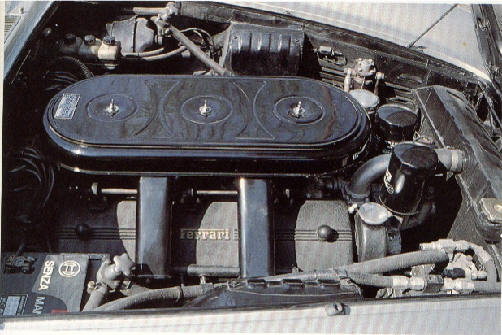 |
The 4-litre, 60-degree V12 engine-compression ratio
with 8.8:1 - was officially credited with 300bhp at 6000rpm (though
probably the output was greater). Fuel was supplied by three Weber 40 DF
I twin-choke downdraught carburettors. |
|
The heart of a world champion The exciting saga of the Ferrari 4-litre, 12-cylinder engine began at Le Mans in April 1962, when the experimental 330 spider took part in special trials organised by the ACF. The car’s tubular chassis (no.0808 was similar to that of the TRI 61; as a result it was the engine that drew all the attention. Credited with more than 390bhp, the new Maranello 12-cylinder was derived from Colombo’s 400 SA, with 77mm bore and 71 stroke, and a new crank. In turn, this was derived from Ferrari's first V12. Ferrari subsequently mounted the same engine in a GTO, which Mairesse and Parkes drove in the Nurburgring 1000 kilometre race on 27 May. The car came a brilliant second behind the mid- engined Dino 246 SP driven by Hill and Gendebien. In the Le Mans 24-hour race, the 330-engined cars the TRI 330 LM (Hill-Gendebien) and the 4-litre GTO (Parke -Bandini) - were side by side on the starting grid. The berlinetta had an unlucky race, running into the sand at the Mulsanne bend. The spider, though, won the race in fine style, demonstrating the power and reliability of its engine. In 1963, the 12-cylinder was also used to power the 330 LM, a splendid coupé which made its debut at Sebring and finished fifth overall at Le Mans. Due to development of the company's more competitive 250 P, further work on the 330 LM was abandoned. However in 1964 its exuberant engine was used in the 330 P, which, with the 275 P, took the laurels in the sports car World Championship. |
|
Technical specifications Engine: front-mounted, 60-degree Bore and stroke: 77 m n 71 mm. Cylinder capacity: 3967 cc. Compression ratio: 8.8:1. Power output; 300bhp at 6600rpm. Valve gear: two per cylinder, operated by chain-driven twin overhead camshafts. Fuel supply: three Weber 40 DFI twin-choke downdraught carburettors. Dry air filter. One mechanical and one electrical fuel pump. |
Electrics: 60 Ah alternator, 12 V
battery. Clutch: dry, single plate. Gearbox: four forward speeds and reverse with Laycock overdrive in fourth. (From 1965, five forward speeds and reverse). Transmission: via propeller shaft Front suspension: independent, with wishbones, coil springs and anti-roll bar. Adjustable hydraulic shock absorbers. Rear suspension: live rear axle, with semi-elliptic leaf springs, radius arms and coil springs. Adjustable hydraulic shock absorbers. |
Brakes: disc brakes all round.
Hydraulically operated twin circuit. Handbrake on rear wheels. Wheelbase: 2650 mm Track: front 1400 mm, rear 1390 mm. Length: 4840 mm. Width: 1710 mm. Height: 1360 mm. Dry weight: 3150lb. Top speed: 153mph. Price: 6,500,000 Lire. |
Italian Cars - Sports and Classic Number 5 - June/July 1991
Copyright 1991, Italian Classic Publication Ltd.
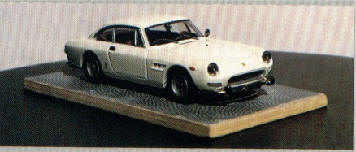 Although
the doors do not open, the handles are featured, and the quarterlights and
all window frames are painted grey.
Although
the doors do not open, the handles are featured, and the quarterlights and
all window frames are painted grey.